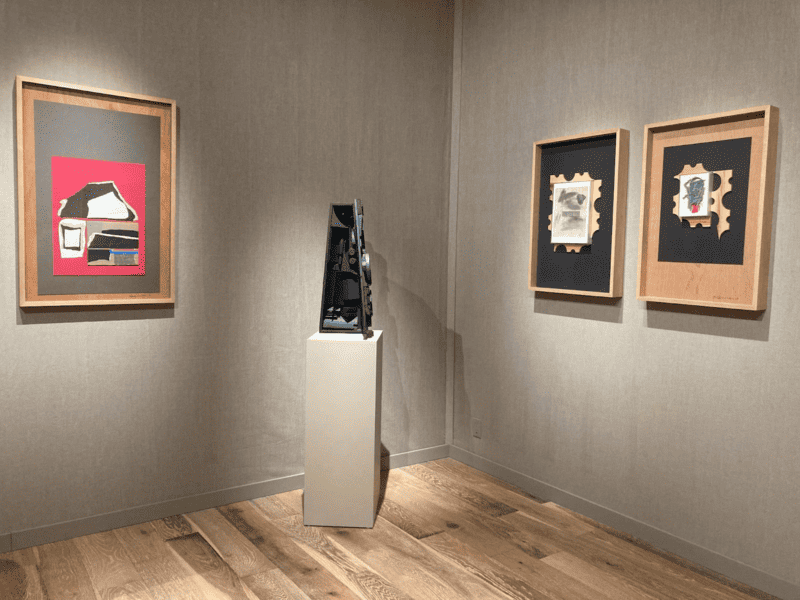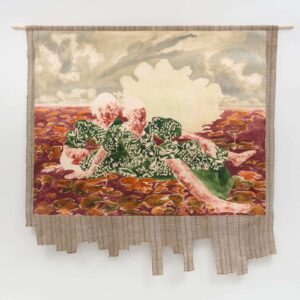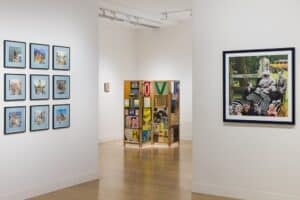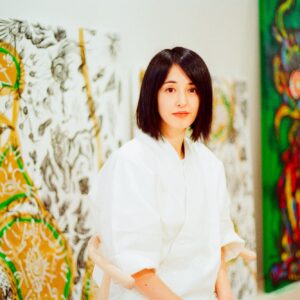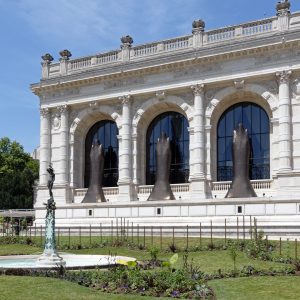
“For me, my mind is an act of resistance. That’s all, I’m saying: ‘I’m not able to change the system, but I’m able to change your point of view, as an artist.’”
Paolo Canevari
Paolo Canevari’s art has been sculpted from the shadows of the modern world, but he hasn’t lost hope. Working with pitch-black rubber, used tires, and exhausted oil, he turns the waste products and omnipresent aftermath of industry into poignant structures that highlight how human beings have reshaped the world. Without submitting to one form or meaning, much like the medium, he bends to his will, the work is made to ceaselessly provoke, and to arrest visitors with the exhibition of raw materials taken for granted elsewhere. He puts a point on how we’ve chosen to live, and much like his ‘Self-Portrait’ – a tire stabbed violently with a switchblade – the pieces hum with this statement of intent. The continuing history of industrialism might be stacked against him, but Canevari is determined to rebel, regardless:
“There is always hope in the soul of an artist.”

The first thing I have to ask about is the tires, and the material that dominates your work. What drew you towards rubber in the first place, and what meanings and atmosphere does it add to the art?
Well, I started to work with rubber, taken from industrial sites or scrap fields, at the end of the 80’s, really 89’. I was interested because of the colour and the rubber-based paint that I used to work with; it was really metallic, really thick, I didn’t like the material. So I thought, why not try to paint with the same thing on something that is actually relatable to the rubber? I started to collect inner-tubes and working with them. The attitude towards the material was different, because the idea was to manipulate the material without really changing it. The shape I found was already there. Let’s say if you take a cube of marble; you change its structure, you change the shape: the inner-tube doesn’t change, it stays the same. I just attach it to a nail on the wall, or unroll it, and that will change the meaning of the thing.
Tires were much more difficult, because they were much more recognisable; they were ugly and dirty, and it was not an easy material to deal with. And that’s probably what grew on me, you know, the idea of making something that could be nice, in shape, but with a material that was strongly connected to something else, and was not easy to work with. I chose it for reasons that are very simple also. I was completely poor as a young artist, I didn’t have any money. I wasn’t able to work with noble material. So I said, why not choose a material that is available everywhere, that I don’t have to transport, because if I go to America or Australia I can find tires there. That what basically brought me to the material, the easiness and availability of it, and the general universal meaning that the material brings with it. That’s the story of my production, it’s always related to the material, to something that already has a meaning. Contemporary art adds a meaning to artwork, so whatever you do, it’s not related to something, it’s always related to a sort of action that you do in the work of art.
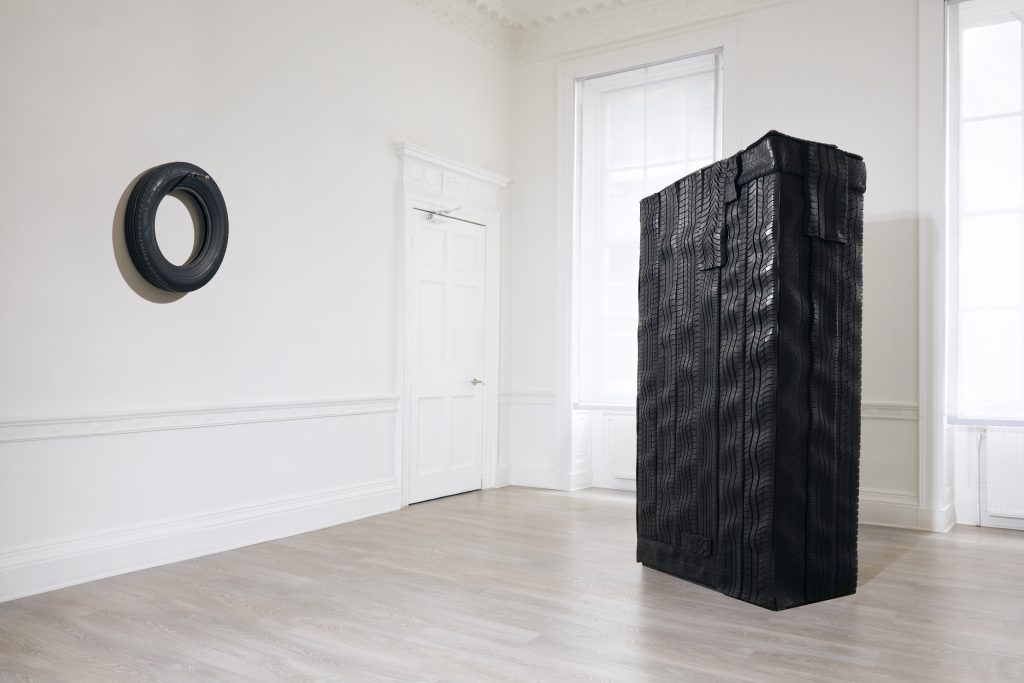
Going along these ideas of a material, of rubber, it seems like it’s so key to the process of wastage and production in modern lifestyles, and looking at your work and the way you’ve manipulated it reminds me somewhat of Marx’s ideas; that you’re returning to the base materials that constitute a system, or way of living. Could you speak to an influence of that way of thinking on your ideas?
There are different methods of interpretation of a work of art, and you can deepen them and find different meanings. Of course, we can scratch the surface, and say that ‘yes’, the tire is a wasted material, it comes from industrial production, it’s the witness of industrialisation, and modernity as well. It’s a symbol, and part of a symbol itself which is the car, and the society based on oil and oil-production products, so cars, driers, plastics, whatever you can think of, and the quintessential element of pollution in the world. Of course the first venture is to scratch the surface and stop, then again you have different layers, a work of art works in those levels, so it depends on what kind of knowledge you have, that’s fundamental. The idea was to give the artwork an idea of a vehicle, a mental vehicle. I think that’s very much what interests me in a work of art, something that really lets you travel with the mind.
That brings to mind J.M.B. and ThANKS, with their placement together in this latest exhibition. They seem to work really well with this idea of a re-appropriation of meaning. Would you say that this is broadly reflected in the rubber as well, because it is so polymorphic?
Well, in a way that’s the case of course; there was literally playing with a material that refers to wars, indirectly. You know, many of the wars we’ve made in the last thirty years were made in the name of interests in oil and the control of it. I was in America in 1991 when the first Gulf War began, and I remember that moment when the United States declared war, and in Iraq, and for me it was a breaking point. I am now someone who’s experienced a real war, in an age when I can be conscious of it, and that never ended basically. There are different interests, but every time it always goes back to economy, and the control of it, and the political control of it. So, playing with those elements which are like stylised tanks, like a game for children, gave name the opportunity to reflect, to rethink about the role of weapons in war, and the conceptual meaning of war itself.
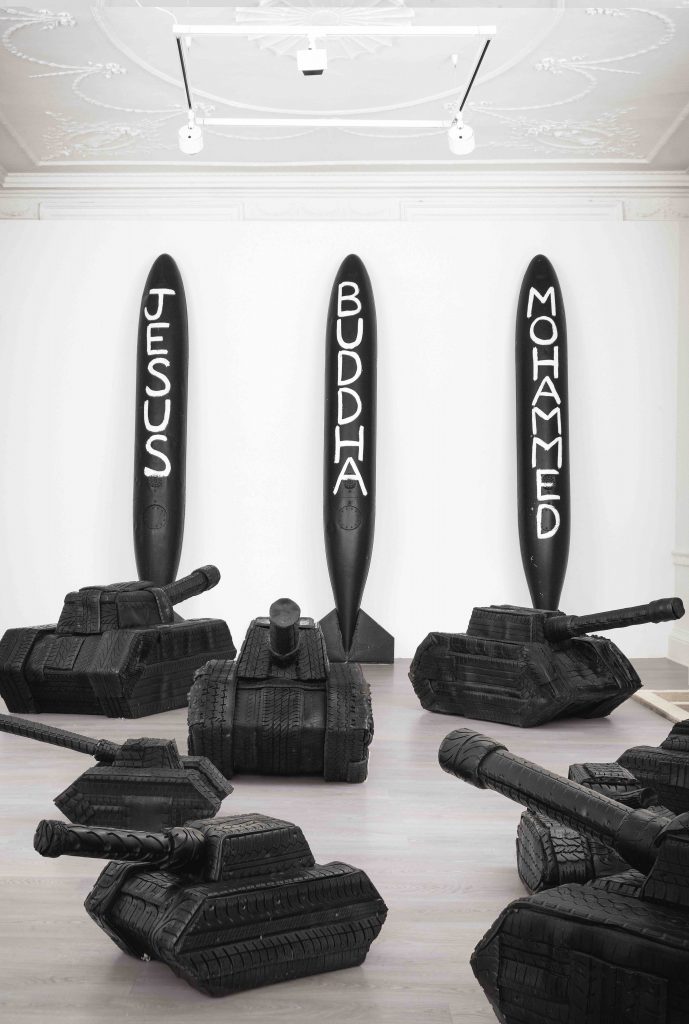
The missiles are strong, in a rhetorical way, and they’re very direct. The work I’m doing now, after all these years, is much more mental, metaphysical, but it used to be direct. I believed that you had to say something in that way, in a very strong way. But then with this, kind of sickness of the politically correct, it became fashionable to speak in a certain way, which was really selfish and superficial, but at the same time I was in a moment where communication and the meaning of images changed so much. Before I wanted to produce a piece that was really strong, but I started to realise between 2005 and 2010 that the politically strong language that I wanted to give was becoming something fashionable, easy to perceive, easy to absorb, and that society somehow came and us to the point where we are. Then I said, that’s the moment we have to do something different, something that is more difficult to grasp; something more metaphysical and poetic, because that’s the way art should be with itself at the moment. To not speak a language that is the same level of the communication networks, social networks, publicity, newspapers, tv. It’s art!
There’s certainly that property to public discourse at the moment, it’s almost like a machine in some ways. It’s really hard to say something which it can’t format or manipulate, and turn it into its own message. Along those lines, though this might sound like a strange question, but would you describe yourself as a political optimist or pessimist?
[Laughs] Well, I’m sure a pessimist, I’m not optimistic in that way. Basically, I’m quite pessimistic about the human race. I think that we should disappear from the planet. I think that would be great; after all we’ve made, 90% of our presence has been damages. But, the 10% is something different. The 10% is art: what men did in history that makes sense. And that’s what I do; that’s my part of hope, it’s what I’m working on. For the rest, I’m very pessimistic. I think that man, for what he did to the planet, for what he did to other, to himself, in a very paternalistic and patriarchal way, deserves to disappear. The only problem I have is that together with him will disappear also art, and art is the only real meaning, the only real sense I have. Other than that, I don’t really see it.
It reminds me of a Hayao Miyazaki quote I heard years ago, about him being very cynical of the film industry, calling it a river of dirt, but that he was trying to produce a drop of clear water every now and then. It sounds like there’s a similarity to your idea of hope.
Yeah, there is a huge difference, which nowadays is a kind of flowering of meaning. The word artist is used many times in different contexts, with different meanings. For me ‘art’ is the only one: and this one is made by an individual, and not by an industry. Whatever cinema, whatever movie structures can make, that can somehow be close to art: it’s not art. It’s made with another purpose, it’s made to make money. I don’t do art because I have to make money. Yeah, of course, there is a market, I have to survive, but at the same time mine is not an industry. I’m not a musician, I’m not a rock star, I’m not an actor who’s part of an industry. I’m an individual, and that’s really important I think. To see that, in that way.
I’m doing things by myself, for myself basically, and if it reaches somebody else, then I’m happy about it, but the work of art is a work of art. It doesn’t really need anybody. It just is itself: nothing else.
I see what you mean. I think especially today, in the way we communicate and our lifestyles, there’s such a sense that everyone is stuck in a society, and always with a context; it’s hard to feel like you can express yourself authentically.
Yeah, art is a way out. Not that everybody’s doing it. I mean, I’m not saying that all artists are doing that, not at all. A few of them are, but many artists are working in the other direction; going towards society, towards economy and so on. They’re working in another kind of direction than mine; and for me that’s unacceptable, I don’t agree with it, but then I’m an individual, so that’s my way of thinking.

It’s interesting how earlier you mentioned man and nature, and especially the negative influence human-kind has had on the planet. What do you think about the Covid-19 Pandemic, do you think it will effect a shift in how we relate to nature?
Of course it can change slightly, a little bit, for some time, the way we are seeing things… But I don’t think it will change the direction of the system. I don’t think so. The impact of Covid will be very strong on populations that are underdeveloped, and nations that don’t have the economy to have the vaccine. That will underline again between societies, and between countries… On the first time I thought it was finally a really democratic kind of happening, I mean something that happened suddenly and was shared by everybody in the same way, but just after a few months changes you can see it. There are differences, and that didn’t level the differences. So again, I’m not really optimistic about changing the society, through the pandemic and through this drama, this really horrible drama with Covid.
I don’t think it’s going to change much. Maybe for few months, for a couple of years, but then the system wants to go on with the same kind of attitude, as it always did. It’s way too powerful to confront, and to change. But you can always your attitude, that’s really important; you have to change your consciousness, and that’s an act of resistance. For me, my mind is an act of resistance. That’s all, I’m saying: “I’m not able to change the system, but I’m able to change your point of view, as an artist. And talking with you, talking with my students, showing my work to people, I let them think. And maybe I can change somebody’s mind.
I suppose it comes back to that idea you mentioned, of hope, or persistence. There might not be a perfect plan to change the world, but you resist anyway. There’s something quite Romantic, and quite powerful about that. To take it back to the exhibition then, from the world shattering events, I found it really interesting how your work changes as we move through it, especially with the shift back towards more 2-D pieces within the frame. Was there a particular moment or idea that caused you to change?
The idea was always to use, to do something related to three dimensional work, so a reflection about the idea of painting. Okay, so it is attached to the wall, and so on, but it is always dealing with the other material. The oil I use is actually a material, it’s not paint. I used to paint with a material, but it’s not paint, even if it’s called ‘oil’; that’s something ironic, because it’s oil on paper or oil on canvas, but it’s not the real thing. It’s not a colour, it’s a material, it’s different, it comes from another world, let’s say. I made those paintings with exhausted, used, oil from engines.
It’s of course a reflection about the idea of a desire to be a painter, to be in nature and to paint landscape, and that again is you know, something impossible to do. We cannot do that anymore. Contemporary art is a language that doesn’t really permit that anymore. I cannot be a painter, like an expressionist painter, who goes into nature and paints landscape, but then again, yes I have a Romantic desire to connect with that idea. To connect with an idea of nature differently. So, those works are more poetical in their structure. I think that could be an answer to the system right now, after all you know, a poetical gesture is really difficult to reproduce. You can reproduce a political gesture, a political image; but a poetical image, that’s very hard to do. It’s something that’s related to your inner self, it’s much more meaningful.
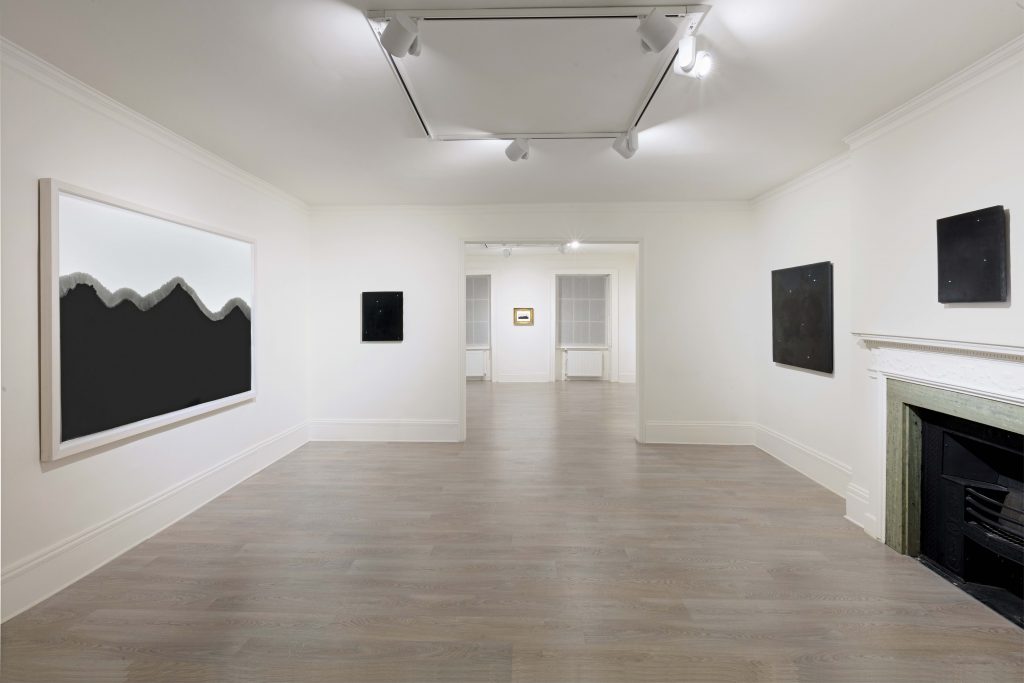
It seems there’s a real sense of engagement throughout your work, with this indomitable society and way of doing things. But it’s not totally pessimistic, there is hope. It’s a lot to think about!
Mine as a position, is again the position of an individual person, of an artist. It’s very personal, so you have to get into my way of thinking, and that can be something that you have to digest. Of course, it’s like a work of art; you get there, you understand part of it, and after one year you understand another part and so on. You grow basically, with an artwork, so the important thing is not to be stuck with a meaning, or an interpretation. What I’m trying to do is give a sort of dis-balance; that is not-balance, that is moving from one place to another, that changes its meaning.
